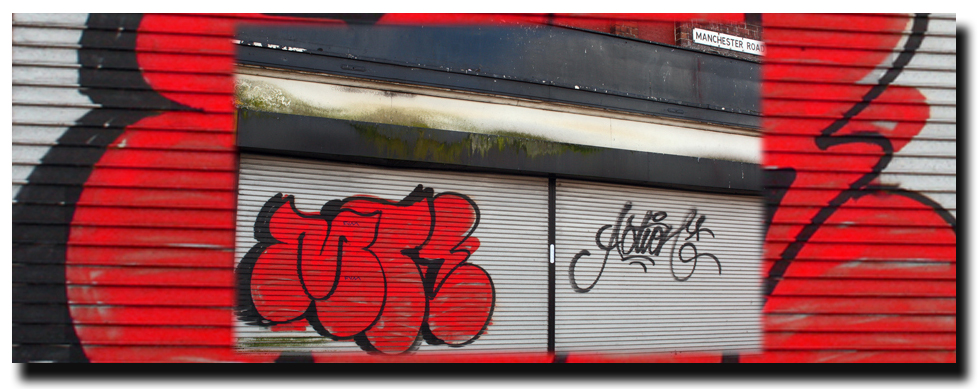
|
Graffiti |
||||||
|
|
||||||

I began taking photographs of graffiti in 1992, concentrating within the Manchester area. During the past fifteen years, I have photographed various types of graffiti, from public toilet scribbles, lovers’ messages carved into trees, to huge sophisticated pieces of graffiti. As a visual artist, I recognised the complexity of some of these pieces of graffiti and photographing these complex pieces seldom required additional imagination on my part. Nevertheless, even a simple piece of graffiti can be made more attractive by the manner in which it is photographed, either by varying the camera angle, changing a lens, the exposure, and/or speed, or depth of field.
I make certain that the way I photograph changes the mundane into the interesting. Occasionally, one has to wait around for countless hours, waiting until certain things come together in a photograph. Despite the fact that it is true that the majority of graffiti is static, a person, animal, or other moving object can make enormous improvements to the composition of ones photographs. At other times, the perfect photograph happens in the blink of an eye, and one has to be prepared to photograph it very quickly, as moments like this can pass within seconds.
Some graffiti artists pay little attention to style or form whilst others spend a great deal of thought and effort in the creation of their work. Contemplating and composing photographs often demands having an aptitude to be familiar with, and to bring out formal qualities. In my opinion, a good photograph should demonstrate one or more of these elements.
My view on graffiti, no matter how small or large, no matter how simple, or complex it is, each piece projects a form of communication from somebody. Quite often, the graffiti ‘artist’, whether it is a young person or an adult, female, or male, protagonist or antagonist, some have chosen arbitrary places or locations. Whilst at other times they may have specifically chosen a particular wall, door, or other part of a building because of its latent appeal to augment their message. In a way, they are accomplishing what all advertisers want, the realization, identification, and dissemination of their ‘brand’.
Graffiti artist names are often called ‘tags’ and can be 'written' in multifarious styles. Some graffiti artists vie with each other, completing pieces that will cover up an adversary’s work or even write the word ‘toy’ next to it, the ultimate insult to the serious graffiti artist. Graffiti artists have a language of their own and invariably communicate with each other in the 'graffiti art world'.
We see graffiti in almost all public places (and even private areas), waiting rooms, schools, public parks, bridges, courtrooms, shops, black cab taxi’s, telephone kiosks, bus shelters and even on buses. In fact, I do not believe there is a protected area where graffiti cannot be brought into being. For some graffiti artists, the more difficult the place for them to adorn with graffiti, the more enticing it is for them to use.
Graffiti can be a declaration reflecting one’s political or social views of society, individual names, or a group’s viewpoint. Graffiti can also cause alarm for those who either do not recognize the meaning inherent within the graffiti piece fully, or do not identify with the same values as the social group that created it. This fear can be because of an inability to interpret the symbolic nature of the artwork and comprehend the underlying significance.
Some say that graffiti makes areas appear untidy, inhospitable and that any neighbourhood with large amounts of graffiti will inevitably contain a large gang culture and many other negative connotations. Sometimes the sight of graffiti can help the imagination conjure up images that make one petrified and fearful for ones safety.
That said, graffiti can tell you more about a community than any newspaper. It can tell you something about the feelings, beliefs, and even personal things such as who is dating whom.
People have mixed feelings regarding graffiti; some frequently describe it as defacement of public property and vandalism. Indeed, it can be. Who would want their property treated in such a way? Although this said, there are talented, serious graffiti artists and this is a persons or groups' only forum, historically, graffiti artists were not recognised as artists per se, vanquished to the walls of buildings, trains and wherever else they could make their art.
Many pieces of graffiti project messages with reference to political, social, or even personal injustices. Graffiti provides us with endless intellectual transactions, mystifying and anonymous aesthetic artefacts which we readily digest and translate into sociological artefacts. Some people see graffiti as stunning embellishments to the inner city landscape. Whichever way of thinking one has, it has to be said that graffiti can convey powerful messages about that particular community or even about society as a whole.
Understanding the meaning of graffiti artists work, whether ‘hidden' or literal has been open to debate and interpretation for many years. Just as various pieces of artwork in a gallery has veiled or ambiguous, meaning, so does some graffiti artwork. Unfortunately, there is no curator standing by the graffiti artwork to explicate the piece to members of the public.
Occasionally, people will distinguish some graffiti as a work of art, dependant on the artist that has created the piece of graffiti. The graffiti artist Banksy has earned quite a lot of money from his work and has helped to attach positive connotations to graffiti.